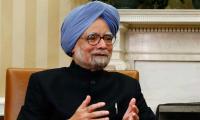PARIS: The James Webb space telescope has discovered massive clusters of stars in the early universe so huge and densely packed that they influenced how their galaxy formed, astronomers said on Monday.
The five clumps of stars, known as globular proto-clusters, are the earliest ever observed, dating back to 460 million years after the Big Bang when the universe was three percent its current age.
They were spotted in the Cosmic Gems Arc, an infant galaxy discovered by the Hubble telescope in 2018. Looking into space means looking back in time, and the galaxy exists in what is called the epoch of reionisation, when the first stars and galaxies emerged and lit up the universe.
It is difficult to see that far back, but the Webb telescope´s ability to detect infrared wavelengths has allowed it peer farther back into this cosmic dawn than ever before.
The discovery of the five globular proto-clusters marks “the first time we have been able to observe this type of object at this distance,” said Adelaide Claeyssens, a co-author of the new study in the journal Nature.
It should help scientists better understand the “formation of star clusters that we can see in the nearby universe -- which are now very old -- and their influence on the formation of galaxies,” the Stockholm University astronomer told AFP.
There is nothing like these clusters in the universe we see around us, said lead study author Angela Adamo, also from Stockholm University.
Our home galaxy, the Milky Way, is now home to around 170 globular clusters. But there were once thousands of them, before they were broken up and scattered when the galaxy expanded, Adamo told AFP.
Those that did survive are relative lightweights, making up an “insignificant” mass compared to all the other stars in the galaxy. However the five clusters in the Cosmic Gems Arc are true heavyweights, representing nearly a third of their galaxy´s total mass.
The young stars are also packed closely together. Imagine there were a million stars jammed into the four light years of space that separate the Sun and its nearest star Proxima Centauri, Adamo said.
A separate study recently suggested that stars near the heart of globular proto-clusters are up to 10,000 more massive than the Sun.
Representational image of empty streets and closed shops in central Maputo ahead of a ruling on disputed elections on...
The flag of Serb Republic on a building in East Sarajevo, Bosnia and Herzegovina, January 9, 2023. —...
US President Joe Biden speaks as he visits the Department of Labor for an event honoring the nation's labor history...
Japanese foreign minister Takeshi Iwaya pictured in a Christmas event in Beijing. — AFP/FileBEIJING: Japanese...
A woman shovels snow on the main street during snowstorm in Sarajevo, Bosnia and Herzegovina, December 24, 2024.—...
A firefighter works at the site of residential buildings hit by a Russian drone strike in Kharkiv, Ukraine on December...







